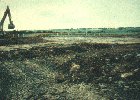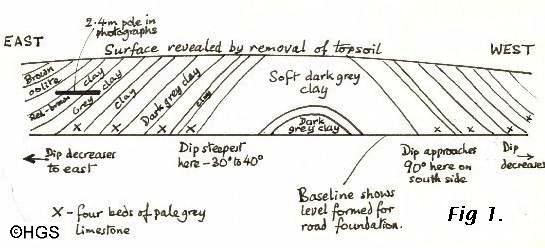

Humberside Geologist no. 11
The Geology of the Market Weighton By pass
click here
to view photo 
In June and July 1990, the construction of the important diversion of the A1079 around Market Weighton was well advanced. There were shallow cuttings commenced near the top of Arras Hill (NGR SE894420; OD 70m) on the A1079(T) and extended downhill for 1200m to Sancton crossroads (NGR SE885410; OD 35m).
Local archaeologist Peter Halkon was leading fieldwork in the area, particularly where the topsoil had been stripped from fields prior to the excavation for the road foundations, and had made significant finds of mainly Romano British material. The site engineer informed Lynden Emery, who was helping with the archaeological studies, that some platy limestone had been discovered unexpectedly at the foot of Arras Hill. This limestone had not appeared in exploratory borings taken prior to commencing work.
A quick visit to see the limestones revealed a vertical section on the northern side of the site, where a large grader had cut down to road base level. It was clear that the exposure would not last long, as the grader was working on the opposite side of the road and large vehicles were working over the strip in between. The only measuring equipment to hand was a range pole, so Lynden drew a field sketch (figure 1) whilst Peter took photographs, and the group made a quick search for archaeological remains. The field sketch shows that the pale limestones, interbedded with clays, have been forced upwards into a narrow anticline. The limestones show scattered ferruginous ooliths.

Three days later, on July 1st, Mike Horne accompanied Lynden to the site and took measurements of the section on the southern side of the road. By this time the slight hump over which dumpers had travelled previously was now cut away to road base contour, thus removing the northern section. The slight hump is still visible on either side of the road, now grassed over, and the feature can be seen continuing eastwards at the base of the Wolds scarp. It might represent evidence of valley bulging, or another explanation is that it might be a wave cut platform from a late stage of the post-glacial Lake Humber.
At the base of the slope, near the site of the new roundabout, there was evidence suggesting the presence of Mercia Mudstone. Further up the slope (NGR SE886412; OD40m) were the beds of limestone and clay which were quite fossiliferous and iron rich, exposed in the foundations of the road and the cutting at the side of the road. They were almost level bedded but exhibited some folding in the side of the cutting, which was sloped at a very low angle. Lynden Emery and Mike Horne logged the exposures (see Figures 2[key and top of log] & 3[rest of log]) and took samples. The log of the cutting is estimated because of the low angle of the bank.
Further up the hill, where a track previously thought to be a Roman Road crossed the by pass (NGR 889415; OD 50m), there was a drainage pit in blue and brown clay. There was Red Chalk and grey Chalk on the sides of the road above the pit (see photograph Humberside Geologist no 8, page 37). Figure 4 is a diagram illustrating the stratigraphy of the site.
The low bank of the cutting was covered over when visited a week later by members of the Hull Geological Society, but fossils were still abundant in the road foundations. Some of these beds were also quite rich in iron and with the macrofossil assemblage, the section seemed to have similarities with the Frodingham Ironstone.
Palaeontology of the site.
Macrofossils from the by pass site are now in the collections of Hull Museums
(numbered DB1990.8.1 to DB1990.8.86), Lynden Emery and Felix Whitham. Microfossil
samples are in the collection of Mike Horne; extra sediment samples were donated
to Hull Museum.
Bivalves:
Bivalves were common in the Lias section exposed in the low cutting
and the foundations of the road nearby. The dominant genus being Gryphea.
Plagiostoma, Cardinia and Modiolus were also found. This
assemblage is similar to that of the Frodingham Ironstone.
A poorly preserved bivalve was found in the Red Chalk.
A specimen of Inoceramus crippsii (no. DB1990.8.70) was
found in the Lower Chalk (Bed E on the log).
Ammonites:
The following Ammonites were found loose
Lower Arietites bucklandi Zone Arietites sp. [ Lower Sinemurian ]
Schlothemia angulata Zone Schlothemia angulata [ Hettangian ]
Alsatites liasicus Zone Caloceras sp. [ Hettangian ]
On a later visit, in October (see Humberside Geologist
no. 8, page 26) Judith Bryce found a specimen of Dactylioceras tenuicostatum
(specimen no. DB1990.8.82), preserved in an ironstone nodule from the blue
and brown clays beneath the Red Chalk (NGR SE889415), suggesting an early
Toarcian date for these beds.
Belemnites: Simon Mitchell writes
"Both specimens lack acro-dorso lateral grooves and although
a little corroded suggest they belong to the Nannobelus group. The
larger narrow specimen (no.DB1990.8.85) has a tendency towards a cylindrical
shape and weak anterior compression (lateral flattening). Only one specimen
is difficult to date accurately but it is most likely to be late Sinemurian
in age (upper oxynotum or early raricostatum zones most likely). The other
specimen (no.DB1990.8.86) shows a general similarity to Phillips' Belemnites
nitidus, but since it lacks acro grooves it is more likely to be a Nannobelus
(Upper Sinemurian age) or Parapassaloteuthis (Upper Pliensbachian basal
Toarcian age). I favour the former.
These two specimens show closest agreement to the Yorkshire Coast
species rather than Dorset species, as we would expect, since the boundary
between the two provinces runs more or less between London and the Pennines."
Specimens of Neohibolites minimus were found in the Red Chalk and the red clay below the hard Red Chalk.
Microfossils:
Sample MWB1 contains the following mesofossils - echinoid spines
(not Cidarid), small bivalve shells, burrow infills, Modiolus, oysters
and Pentacrinus. The microfossil assemblage is dominated by ostracods,
0gmoconchella ellipsoidea (Jones 1872) being very common, indicating
a Hettangian to early Sinemurian age. The foraminifera include Lingulina
tenera collenoti (Terquem) which has a late Triassic to Hettangian range.
Sample MWB2 contains over 90% muscovite in the processed material,
along with some limonite and carbon. The only microfossils present are some
large simple agglutinated foraminifera.
Sample MWB3 contains quartz, muscovite, limonite and phosphate
in the processed material. No microfossils were found, but specimens of fish
teeth, plant remains, faecal pellets and a corroded echinoid spine were observed.
Sample MWB4 contains the following mesofossils - Terebratulina,
Inoceramid bivalve fragments, fish teeth, echinoid plates, oysters, Cidarid
and irregular echinoid spines. The microfossil assemblage is mainly composed
of benthic foraminifera, with calcareous and agglutinated forms being equally
common. The dominant calcareous form is Gavelinella; the agglutinated
forms are Ammodiscus, Arenobulimina, Tritaxia, and Marssonella.
There are few planktonic foraminifera, but there are some ostracods. Faecal
pellets, bryozoa and a small ?Porosphaera, are also present, along
with grains of quartz and iron minerals.
Sample MWB5 contains the following mesofossils - Terebratulina,
echinoid spines, bryozoa and fragments of Inoceramus. Among the microfossils
planktonic foraminifera are rare. Benthic foraminifera are represented by
Ammodiscus, Dorothia, Tritaxia, Arenobulimina,
Eggerellina, Marssonella, Lenticulina, Gavelinella,
Spirilina and Stensioina. Faecal pellets are also present in
the sample.
Conclusions.
The dates from the belemnites, ammonites and microfossils found in or near the shallow cutting (SE886412) all indicate a Hettangian to Sinemurian age for these beds.
The presence of D. tenuicostatum indicates an early Toarcian age for the blue clay (at SE889415) below the Red Chalk, which itself contains the typical Neohibolites minimus of Albian age.
The Chalk (at SE891417; ca. 63m OD) contains Inoceramus crippsii indicating early Cenomanian age, which is supported by the microfossil assemblages
The suggested geological succession depicted in figure 5 is based on the following data:
The section estimated in July 1990.
Comparisons with the log of the British Geological Survey borehole at Cockle Pitts (NGR SE932286) (in Gaunt et alii 1992), made possible by fossil determinations, proving beds from the basal Lower Lias to the uppermost beds of the Middle Lias at Arras Hill.
Similar exposures observed at North Cliffe (NGR SE875375) by Felix Whitham in 1965, with comparative fossil successions.
The progressive reduction in thickness of the Lower and Middle Lias beds, about 70m at Cockle Pits and about 45m at North Cliffe, demonstrating the northerly attenuation of these beds over the Market Weighton High. It is emphasised that the succession in column 4 of figure 5 is based on percentage values between Cockle Pits and Arras Hill.
Acknowledgements.
Many thanks are due to Humberside County Council who allowed
access to the roadworks and provided Lynden Emery with details of shallow
borings and trial pits made along the route of the by pass; Prof. Judith Bryce
who found the Dactylioceras specimen and donated it to Hull Museum;
and Mike Boyd who provided the Hull Museum accession numbers.
References.
de Boer G, Neale J W and Penny L F. 1958. A guide to the geology of the area between Market Weighton and the Humber. Proceedings of the Yorkshire Geological Society 31,157 209.
Gaunt G D, Fletcher T P and Wood C J 1992. The Geology of the Country around Kingston Upon Hull and Brigg. Memoir for 1:50000 geological sheets 80 and 89 (England and Wales). H.M.S.O., London. ix + 172 pp, 6 pl. ISBN 0 11 8843990
copyright Hull Geological Society 2020